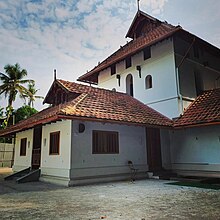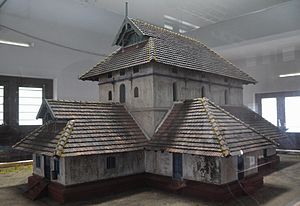Cheraman Juma Mosque
An editor has expressed concern that this article may have a number of irrelevant and questionable citations. (June 2019) |
| Cheraman | |
|---|---|
 Restored Masjid as of July 2022 | |
| Religion | |
| Affiliation | Sunni Islam |
| District | Thrissur |
| Location | |
| Location | Methala, Kodungalloor |
| State | Kerala |
| Territory | India |
| Geographic coordinates | 10°13′12″N 76°11′38″E / 10.22°N 76.194°E |
| Architecture | |
| Completed | 1568 |
| Specifications | |
| Length | 61 m (200 ft) |
| Width | 24 m (79 ft) |
The article's lead section may need to be rewritten. The reason given is: Contentious claims, possible misrepresentation of sources, weak sources and strongly contradictory content. (April 2024) |
The Cheraman Juma Mosque is a popular prayer centre in Kodungallur in Thrissur district. According to hagiographical legends, it is claimed that the mosque was built in 629 CE by Malik Bin Dinar.[1]
It is claimed to be the first mosque to be built in India.[2][3] It is claimed to be the oldest mosque in the Indian subcontinent which is still in use.[4][5][6]
The mosque was constructed in Kerala style with hanging lamps, making the historicity of its date claims more convincing.[7][better source needed][8][better source needed][9][better source needed][10][better source needed][11][better source needed][12][better source needed][13][better source needed] Other scholars are more skeptical and dated the structure to the 14th-15th century based on the architectural style.[14]
The mosque was destroyed by the Portuguese in 1504 when Lopo Soares de Albergaria attacked the port of Kodungallur. The old building was built some time after the 1504 de Algabaria attack (i.e., from mid-16th to the early 17th century). Modern corridors and halls were built in 1984. The 1984 extensions, which surround the old building, conceal almost all of the exterior features of the old building.[15]
Legend
[edit]One legend says it was built in 629 CE,[2][3] another legend says it was built in 643 CE.[citation needed]
According to some legends, the Chera king Cheraman Perumal witnessed the splitting of the Moon,[citation needed] a supernatural event mentioned in the Quran[16] as a miracle performed by Muhammad when asked for one by Meccan unbelievers. The bewildered King confirmed[citation needed] with his astrologers that the incident had taken place, but didn't know what to make of it. Arab merchants who had arrived at a Malabar port, a bustling global marketplace, sought audience with the King to have his permission to visit Ceylon. In conversation with them, the King learnt about Muhammad,[citation needed] made his son the regent of his kingdom and travelled back with the Arab merchants to meet the man himself.[citation needed]
The story goes that Cheraman Perumal arrived in Arabia with a gift of ginger pickles for Muhammad and his companions[17] and converted to Islam "at the feet of Prophet Muhammad".[18]
According to historian M.G.S. Narayanan, "there is no reason to reject the tradition that the last Chera king embraced Islam and went to Mecca, since it finds its place not only in Muslim chronicles, but also in Hindu brahmanical chronicles like the Keralolpatti, which need not be expected to concoct such a tale which in no way enhances the prestige of the Brahmins or Hindu population."[19][20] Scholar Mehrdad Shokoohy however traced such legends to a much later accounts with different dating than the supposed earlier date.[21] Historical research has found this story to be fictitious.[22]
Andre Wink mentions that, this is a traditional story in the Mappilla community of Kerala. This community was formed by the Arab traders in medieval times. They became part of Kerala society with muta (temporary marriage) custom with the local fisherwomen.[23] Their children were raised in the teachings of Sunni Islam. This ethnogenesis of Mapilla took place in 13th-14th centuries. This is when we encounter the presence of a community called Mapilla for the first time in history.[24]
S. N. Sadasivan contends in A Social History of India that Kalimanja, the king of the Maldives, was the one who converted to Islam. The story of Tajuddeen in the Cochin Gazetteer may have originated because Mali, as it was known to sailors at the time, was mistaken for Malabar (Kerala).[25]
Mention of the Cheraman Mosque in history books
[edit]
Several early Muslim or Arab travelers have visited Kerala in medieval times. Among them was Arab traveler Sulaiman, Persian traveller Nakhuda Buzurg, Ibn E Batuta, Abd-Al-Razzaq etc. None of them mentioned about Cheraman Juma Mosque in their writings.[26][27][28]
The early or medieval travelers who visited Kerala includes Sulaiman, Al Biruni, Benjamin of Tuleda, Al Kazwini, Marco Polo, Friar Odoric, Friar Jordanus, Ibn Battuta, Abdur Razzak, Nicolo-Conti etc. None of them wrote about the legend of Cheraman Perumal’s conversion.[29]
The time period of early and medieval travelers who travelled Kerala are as follows:
| Year (CE) | Name | Short Description | Reference |
|---|---|---|---|
| 851 | Sulaiman | Arab traveler | [26] |
| 951 | Nakhuda Buzurg | Persian traveller | [28] |
| 1342 | Ibn E Batuta | [29] | |
| 1442 | Abd-Al-Razzaq | [29] |
Location
[edit]Masjid is located in the Paravur–Kodungalloor Road, NH-66 at Kodungalloor taluk, Thrissur District in Kerala.
Appointment of the Aven (Priest)
[edit]According to Chellikkattil Sundaran, president of the temple trust, the aven (priest) of Shobhaparamba Sreekurumba Bhagavati temple in Tanur, Malappuram, is traditionally appointed from the local Thiyya family by a member of the Brahmin family of Pazhayakhath Ilom. The family disintegrated over the years and its remaining members converted to Islam but both the temple authorities and the family upheld the tradition. The temple's Hindu priest is appointed in a special ritual once every 12 years, presided over by a Muslim member of the Pazhayakath family, who makes the formal announcement. Locals ascribe this camaraderie to Cheraman Perumal.[18][30]
Maharajahs of Travancore
[edit]The legend of the "Makkattupoya Perumal" or "the King who went to Makkah (Mecca)" has lived on in Kerala memory and apparently, the Maharajahs of the Princedom of Travancore in pre-Independence India would say at their swearing in, "I will keep this sword until the uncle who has gone to Makkah returns".[31]
Notable visitors
[edit]- A. P. J. Abdul Kalam, 11th President of India.[32]
- Shashi Tharoor, Member of Parliament from Thiruvananthapuram, Kerala.[33]
See also
[edit]- Islam in India
- Malayali Muslims
- Muslim chronicles for Indian history
- Muziris Heritage Project
- Baba Ratan Hindi
References
[edit]- ^ Ron Geaves (2017). Islam and Britain: Muslim Mission in an Age of Empire. Bloomsbury. p. 6. ISBN 978-1-4742-7175-2.
- ^ a b Ron Geaves (2017). Islam and Britain: Muslim Mission in an Age of Empire. Bloomsbury. p. 6. ISBN 978-1-4742-7175-2.
- ^ a b "CheramanJuma Masjid - the first mosque to be built in India at Kodungalloor". Kerala Tourism. Retrieved 11 March 2024.[better source needed]
- ^ "Mosque in Kerala dates back to the Prophet's time". The Times of India.
- ^ Anandan, S. (19 July 2015). "Tinkering with the past". The Hindu.
- ^ "India's oldest mosque Cheraman Juma Masjid set to reopen after renovation". Onmanorama. Retrieved 30 October 2024.
- ^ "Oldest Indian mosque sets new precedent". Deccan Herald. 9 July 2011.
- ^ "1400-year-old mosque to be restored to its original form". The Hindu.
- ^ "INTERVIEW". iosworld.org. Archived from the original on 4 October 2018. Retrieved 15 November 2018.
- ^ "Cheraman Juma Masjid: A 1,000-year-old lamp burns in this mosque". The Times of India.
- ^ "Solomon To Cheraman". Outlook India.
- ^ "'Cheraman Juma Masjid': The first mosque of India, built in 629". Siasat.[dead link]
- ^ "Cheraman Juma Masjid: Kerala mosque built during Prophet's lifetime". Gulf News.
- ^ Shokoohy, Mehrdad "Muslim Architecture of South India: The Sultanate of Ma'bar and the Traditions of the Maritime Settlers on the Malabar and Coromandel Coasts (Tamil Nadu, Kerala and Goa)" Psychology Press, 2003, p. 139-142.
- ^ Shokoohy, Mehrdad. Muslim Architecture of South India: The Sultanate of Ma'bar and the Traditions of the Maritime Settlers on the Malabar and Coromandel Coasts (Tamil Nadu, Kerala and Goa). RoutledgeCurzon, 2003. pp 139-42.
- ^ "Surah Al-Qamar [54:1]". Surah Al-Qamar [54:1]. Retrieved 15 November 2018.
- ^ "The Kerala king who embraced Islam". Arab News. 9 February 2012. Retrieved 15 November 2018.
- ^ a b "The Syncretic Treasure of India's Oldest Mosque". Madras Courier. 26 May 2017. Retrieved 15 November 2018.
- ^ M. G. S., Narayanan (1996). Perumals of Kerala: Political and Social Conditions of Kerala Under the Cēra Perumals of Makotai (c. 800 A.D.-1124 A.D.). Kerala (India): Xavier Press. p. 65.
- ^ Raṇṭattāṇi, Husain (2007). Mappila Muslims: A Study on Society and Anti Colonial Struggles. Other Books. ISBN 9788190388788.
- ^ Shokoohy, Mehrdad. Muslim Architecture of South India: The Sultanate of Ma'bar and the Traditions of the Maritime Settlers on the Malabar and Coromandel Coasts (Tamil Nadu, Kerala and Goa). RoutledgeCurzon, 2003. pp 141.
- ^ Prange, Sebastian R. (3 May 2018). Monsoon Islam: Trade and Faith on the Medieval Malabar Coast. Cambridge University Press. pp. 94–5, 100. ISBN 978-1-108-42438-7.
- ^ Wink, André. Al-Hind, the Making of the Indo-Islamic World: Early Medieval India. p. 71.
- ^ Wink, André. Al-Hind, the Making of the Indo-Islamic World: Early Medieval India. p. 72.
- ^ S.N., Sadasivan (January 2000), "Caste Invades Kerala", A Social History of India, APH Publishing, p. 303,304,305, ISBN 817648170X, archived from the original on 25 November 2023, retrieved 31 January 2021
- ^ a b Menon, A Sreedhara. A Survey Of Kerala History. p. 95.
- ^ Wink, André. Al-Hind, the Making of the Indo-Islamic World: Early Medieval India.
- ^ a b Buzurg, Nakhuda. Ajaib Al-Hind.
- ^ a b c Menon, A Sreedhara. A Survey Of Kerala History. p. 121.
- ^ "Where traditions break communal divisions - Times of India". The Times of India. Retrieved 15 November 2018.
- ^ Katz, Nathan (18 November 2000). Who Are the Jews of India?. University of California Press. ISBN 9780520213234.
- ^ "Kerala News : President visits oldest mosque in sub-continent". The Hindu. 30 July 2005. Retrieved 15 November 2018.[dead link]
- ^ "Shashi Tharoor on Twitter". Twitter. Retrieved 15 November 2018.

